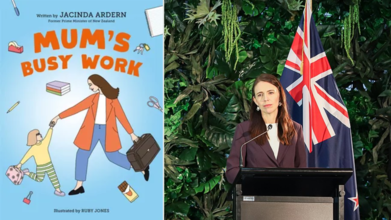- Health Conditions A-Z
- Health & Wellness
- Nutrition
- Fitness
- Health News
- Ayurveda
- Videos
- Medicine A-Z
- Parenting
- Web Stories
Decoding Baby Cries: What Are They Really Saying?

Credits: Canva
For new parents, a baby’s cry can feel like an unsolvable riddle. Is it hunger, fatigue, discomfort, or something more complex?
While the sound of a crying baby can stir panic and helplessness, researchers say that it’s actually the first language a newborn uses to communicate. Learning to interpret these cries can build trust, reduce frustration, and strengthen the parent-child bond.
The Language of Cries
According to research by Priscilla Dunstan, babies across the world, regardless of culture or language, produce nine distinct sounds in their cries, each indicating a specific need. These are not random wails but physiological reflexes.
For example, when a baby is hungry, the tongue touches the roof of the mouth, creating a “Nèh” sound. Identifying these subtle cues early can prevent discomfort from escalating into distress.
The Nine Cries and What They Mean
Nèh – “I’m hungry”
This sound mimics a sucking motion. It’s usually the first cry parents hear, especially in the early weeks when feeding is frequent.
Èh – “I need to burp”
A short, jerky sound created when air is trapped. If you hear this after feeding, hold the baby upright and pat gently on the back.
Aoh – “I’m sleepy”
This cry often comes with yawns and a wide-open mouth. It signals that your baby needs rest soon.
Éérh – “I have a stomach ache”
Hoarse, prolonged, and strained, this cry is linked to gas or colic. Gentle massage or movement may help soothe your baby.
Héh – “I’m uncomfortable”
A soft 'h' sound may point to issues like a dirty diaper, awkward position, or rash. A quick check can resolve it.
Guèn – “I’m teething”
Often accompanied by drooling and gum rubbing, this sound means your baby may need a teething ring or gentle gum massage.
Lelaol – “I need company”
A softer, almost meowing sound—your baby simply wants interaction. Responding to this helps foster emotional security.
Nah – “I’m thirsty”
A gentler version of the hunger cry, often heard in warmer weather or when breastfeeding intervals increase.
Ouin – “Everything feels wrong”
A full-body cry when a baby is overwhelmed. Cuddling, rocking, or just holding them can bring comfort.
Beyond Sounds: Emotions And Connection
While deciphering these cues helps meet basic needs, it also supports a baby’s emotional growth. Babies experience emotions intensely, and crying is their only outlet. Your calm presence helps regulate their emotional storms, almost like serving as their temporary “prefrontal cortex”, the part of the brain responsible for emotional regulation, which develops later.
Should You Always Respond?
Some parents wonder if responding to every cry will spoil the baby. Experts say that in the early months, every cry deserves attention. It isn’t about temperament, it’s communication. As the baby matures, short self-soothing intervals can be introduced. Still, your consistent presence helps develop secure attachment and emotional resilience.
Childhood Obesity Raise Alarm In Indiana: Rates Have Increased By 83%, What Problems Are Children Facing Due To It

(Credit-Canva)
While recent research has shown that children with obesity rates have been rising, a new report showed exactly how fast and high the rates have become within the span of a few years.
September is National Childhood Obesity Awareness Month, and new data from the Indiana Youth Institute (IYI) and Jump IN for Healthy Kids shows a troubling trend. The report highlights that one in five children in Indiana, aged 2 to 19, are living with obesity.
This is a significant problem with wide-ranging consequences. The most alarming finding is a dramatic 83% increase in obesity among children ages 2 to 5 between 2014 and 2023, with much of this rise happening during the pandemic.
Childhood obesity has been linked with numerous health problems, whether it is decrease in the quality of life or even premature death according to HPI (Health Policy institute). It has also been named as a risk factor of the 4 leading causes of death in the US, which are coronary heart disease, type-2 diabetes, stroke and cancer.
How Is Obesity Affecting Children
One Childhood obesity isn't just a matter of weight. It deeply impacts a child's overall well-being.
Physical Health
Kids with obesity are at a much higher risk of developing serious medical conditions. This includes type 2 diabetes, high blood pressure, and orthopedic issues caused by the extra weight on their growing bones and joints. These problems can follow them into adulthood, leading to chronic diseases.
Emotional and Social Well-being
The struggle with obesity can also affect a child's mental state. They may experience low self-esteem and anxiety, which can cause them to feel insecure and withdraw from social activities. This may lead to them skipping school or avoiding extracurricular activities they might otherwise enjoy.
Economic Impact
There are also significant financial costs. A child with obesity is estimated to have $19,000 more in lifetime medical costs than a child who is at a healthy weight. This places a financial burden on families and the healthcare system.
What's Causing This and What Can We Do?
Several factors contribute to childhood obesity, including genetics, access to healthy food, opportunities for physical activity, and neighborhood safety. HPI explains that obesity is linked with physical inactivity. Two factors that caused it were over-reliance on electronics for entertainment and decreased participation in physical education programs in school
Economic challenges can also push families toward less expensive, highly processed foods instead of fresh, nutritious options. This makes it harder for them to maintain a healthy diet, even when they know it's important. The good news is that solutions are within reach. It's a complex problem that requires a combined effort from everyone.
- Families can start by setting good examples. This means eating nutritious meals together and limiting the amount of time spent in front of screens.
- Schools can help by making sure children get daily physical activity and have access to healthy meal options during the school day.
- Policymakers and community groups can work on a larger scale by improving access to affordable, healthy food and creating safe places for kids to play and be active.
The key is to work together without blame or shame. As Tami Silverman of the IYI says, it’s about taking practical steps as a community to create lasting change for our kids.
Jacinda Ardern's New Book Talks About Mum's Guilt And Other Parenting Lessons Working Moms Can Benefit From

Credits: Pac Macmillan and Wikimedia Commons
Jacinda Ardern, New Zealand’s former Prime Minister, has captured hearts once again, not through politics, but through storytelling. Her children’s book, Mum’s Busy Work, offers a heartfelt glimpse into the life of a working mother from the perspective of her daughter, Neve.
Released shortly after her memoir, the book resonates deeply with parents who juggle professional responsibilities and family life, offering lessons about work-life balance, parental guilt, and the modern dynamics of caregiving.
A Child’s Perspective: Seeing the World Through Neve’s Eyes
The best part about Mum’s Busy Work is the narration by Neve, Ardern’s daughter. This makes the book innocent and captures the small moments and big emotions that define a child’s experience of having a working mother.
From noticing her mother’s “big briefcase” to exploring the Prime Minister’s office during a visit, Neve offers a window into the feelings children experience when their parents are often busy or away. The story is not about political milestones or public achievements, it is about emotions: the excitement, curiosity, worry, and joy that fill a child’s daily life.
How Can Jacinda's Book Benefit Working Mother
Through Neve’s eyes, parents are reminded that children are sensitive to more than just presence, they notice moods, energy, and small gestures.
On Mondays, Neve stomps her feet at daycare, expressing frustration at the separation, yet by the end of the week, she delights in dancing with her mother in “clippy-cloppy” work shoes. This oscillation between anxiety and joy emphasizes that children value meaningful interactions, no matter how brief, over constant presence.
Also Read: What Is Leucovorin - The Drug Trump Suggests As A Treatment For Autism?
Normalizing Working Mothers and Challenging Gender Stereotypes
One of the book’s most powerful messages is that working mothers are normal, capable, and loving. In a society where mothers are often expected to prioritize childcare over careers, Ardern’s story is refreshing. Neve sees her mother both as a caregiver and as a professional, demonstrating that a parent’s career does not reduce their love or attention.
The story also subtly challenges traditional gender roles. Clarke Gayford, Ardern’s partner, is shown actively participating in household chores and spending quality time with Neve.
Scenes like Gayford doing the washing or joining for a Saturday picnic present a balanced, modern view of parenting. This stands in contrast to conventional children’s books, where mothers often remain home as nurturers while fathers are portrayed as the fun, adventurous parent.
By presenting caregiving and play as shared responsibilities, Ardern normalizes equality within the household and sets an example for children about inclusive family roles.
Navigating Mum Guilt and Embracing Work-Life Balance
Ardern’s story also addresses a universal challenge for working mothers: “mum guilt.”
The constant worry about not spending enough time with children is something Ardern admits to experiencing, particularly while serving as New Zealand’s youngest Prime Minister to give birth in office.
Yet Mum’s Busy Work conveys that guilt is often self-imposed. As Ardern reflects, her daughter’s questions and experiences did not amplify the guilt, it was created by her own expectations.
For parents, this is a crucial takeaway: balancing career and family requires acknowledging your feelings, accepting that perfection is unattainable, and finding peace in the moments you can dedicate to your children. It’s about being fully present in the time you have, whether it’s reading, dancing, or simply playing together, rather than obsessing over how many hours you spend in the day.
The book also highlights the importance of flexibility and working on your own terms. Ardern shows that professional fulfillment and motherhood are not mutually exclusive. By integrating snippets of daily life—playing hide-and-seek, chocolate treasure hunts, and shared routines—she illustrates that parents can craft their schedules and interactions in ways that prioritize connection and love.
Celebrating the Parent-Child Bond
At its heart, Mum’s Busy Work celebrates the bond between parent and child. Neve’s delight in dancing, reading, and playing with her mother reinforces the idea that children value presence, attention, and shared experiences above all else. The book emphasizes emotional closeness, reassuring children that even when their parents are busy with work, their love remains constant.
The story’s illustrations, by Ruby Jones, complement this message beautifully. Using a colorful and expressive style, the images capture Neve’s moods and perspective, from the anxiety of separation to the joy of shared play. The visual storytelling enhances the narrative, making the emotional nuances accessible even to the youngest readers.
Lessons for Modern Parents
Mum’s Busy Work is more than a children’s story, it is a guide for modern parenting. Here are some key takeaways:
Quality over quantity: Focus on meaningful interactions rather than the total time spent. Even brief, engaged moments can leave lasting impressions on children.
It’s okay to work: A parent’s career does not diminish their love or ability to nurture. Children benefit from seeing parents pursue passions and responsibilities.
Share household responsibilities: Household chores and caregiving should be shared, modeling equality and teamwork for children.
Embrace imperfection: Accept that balancing work and parenting is challenging. Let go of self-imposed guilt and focus on what truly matters.
Build a support system: Friends, family, and partners play a critical role in helping parents manage responsibilities while maintaining emotional connection with their children.
Challenge gender norms: Encourage children to see caregiving and fun as shared roles, breaking traditional stereotypes about mothers and fathers.
A Subtle Feminist Statement
While the book is heartwarming, it also carries a subtle feminist undertone. By positioning herself as both a mother and a professional, Ardern subverts the traditional notion that women must choose between career and family. She demonstrates that it is possible to define success on one’s own terms while nurturing the next generation.
Pediatric Expert Explains How to Spot and Treat Constipation in Children

Credits: Canva
When a child struggles with constipation, the problem can ripple through the whole household, creating discomfort, stress, and frustration. While parents often worry about how many times their child goes to the bathroom, one leading pediatric expert says that frequency is not the most important measure. Instead, what matters most is stool consistency.
Consistency, Not Frequency
According to Dr. Jaya Punati, a neurogastroenterologist and co-director of the Colorectal and Pelvic Anomalies Program at Children’s Hospital Los Angeles, constipation is often misunderstood.
“Constipation is not frequency of stooling,” she explained in a statement quoted by USA Today. “Constipation is consistency of stooling.”
Healthy stool should be soft and easy to pass, resembling a coil or soft pile—similar to the familiar “poop emoji.” Hard, dry stool, on the other hand, is a clear sign of constipation.
Normal bowel movement frequency can vary greatly among children, ranging anywhere from three times a week to three times a day. For this reason, parents should focus on how stools look and feel, not on how often bathroom visits occur.
The Role of Diet and Hydration
The first line of defense against constipation begins at the dining table. Dr. Punati highlights the importance of diet and hydration, noting that children should eat five to six servings of fruits and vegetables daily, each accompanied by a cup of water.
“Dry food, dry poop,” she emphasized, explaining that fiber-rich foods paired with water bring needed moisture into the colon, softening stool and making it easier to pass.
While fiber supplements like psyllium or flax seeds are widely available, Dr. Punati cautions parents not to rely on them as the first solution. “It’s better to eat an apple than to take a fiber pill. They’re not equivalent,” she said. Whole foods also support the gut microbiome, which plays a crucial role in overall digestive health.
Mushers and Pushers: Medication Options
For children with stubborn or chronic constipation, dietary changes may not be enough. In such cases, medication can help, and Dr. Punati categorizes treatments into two broad types: “mushers” and “pushers.”
Mushers (Osmotic laxatives): These draw water into the colon, softening stool. MiraLAX, which contains polyethylene glycol, is a common option. Other mushers include magnesium, mineral oil, and sugar syrups such as lactulose or Karo corn syrup.
Pushers (Stimulant laxatives): These trigger muscle contractions to move stool along. Options include senna, bisacodyl, and glycerin suppositories.
Dr. Punati generally recommends starting with mushers for a gentler effect before considering stimulant options.
When to Seek Medical Help
While many cases of constipation can be managed at home, there are times when professional intervention is necessary. Dr. Punati advises parents to call a pediatrician if a child’s stool does not improve after a week of dietary adjustments and over-the-counter treatments.
Soiling, or involuntary leakage of liquid stool, is a sign of severe constipation. While it is not an emergency, it should prompt a doctor’s visit.
However, urgent care is needed if a child experiences severe abdominal pain and is unable to pass any stool. In such cases, Dr. Punati recommends heading straight to the emergency room.
Takeaway for Parents
Constipation in children is common, but it doesn’t have to be overwhelming. The key takeaway, experts say, is to watch stool consistency rather than frequency, ensure kids get enough fruits, vegetables, and fluids, and use medication cautiously when necessary.
If constipation persists despite home efforts, parents should not delay in seeking medical advice. As Dr. Punati told USA Today, “If you are unable to find a solution at home, you should bring it to a doctor’s attention.”
© 2024 Bennett, Coleman & Company Limited

